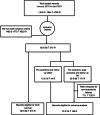Outcome of selective root canal retreatment-A retrospective study
- PMID: 36403111
- PMCID: PMC10100215
- DOI: 10.1111/iej.13871
Outcome of selective root canal retreatment-A retrospective study
Abstract
Aim: Selective root canal retreatment is when the treatment is limited to root(s) with radiographic evidence of periapical pathosis. The goals of this retrospective study were as follows: (i) evaluate the clinical and radiographic (periapical radiographs [PR] or cone-beam computerized tomographs [CBCT]) outcome of selective root canal retreatment after ≥12 months follow-up; (ii) evaluate the periapical status of the unretreated roots; and (iii) assess tooth survival.
Methodology: A retrospective study (January 2018 to April 2021) was conducted to identify permanent multirooted teeth that underwent selective root canal retreatment. Clinical records, PR and CBCT were examined to ascertain variables of interest. Outcomes (per root and per tooth) were classified into 'favourable' or 'unfavourable' using well-established clinical and radiographic healing criteria. Treatment outcomes for the whole tooth and per root were compared as well as bivariate associations between the treatment outcome of the retreated roots and the treatment-related parameters (quality of root filling, sealer extrusion, iatrogenic mishaps and type of restoration) were analysed using Fisher's exact test (α = .05). Survival was recorded in months.
Results: A total of 75 teeth (195 roots) in 75 subjects were available for outcome analysis. The favourable outcome per tooth was 86.7%. At follow-up, 92.6% of the retreated roots had a favourable outcome. From the unretreated roots, 3.5% showed radiographic signs of an emerging periapical lesion. No statistical difference was shown between the outcomes per root and per tooth between both groups. None of the treatment-related parameters had a direct influence on the outcome of the retreated roots. The survival rate at 12-48 months after retreatment was 91.5%.
Conclusions: Selective root canal retreatment is associated with a favourable outcome in a majority of cases. Unretreated roots rarely developed radiographic signs of a new periapical lesion at follow-up. Future high-quality clinical trials with larger sample sizes and longer follow-up periods are required to confirm these findings.
Keywords: cone-beam computed tomography; endodontic outcome; minimally invasive; nonsurgical retreatment; periapical radiography; selective root canal retreatment.
© 2022 The Authors. International Endodontic Journal published by John Wiley & Sons Ltd on behalf of British Endodontic Society.
Conflict of interest statement
The authors declare that they have no conflicts of interest in relation to this study.
Figures


References
-
- AAE . (2009) AAE consensus conference recommended diagnostic terminology. Journal of Endodontics, 35(12), 1634. - PubMed
-
- Al‐Nuaimi, N. , Patel, S. , Austin, R.S. & Mannocci, F. (2017) A prospective study assessing the effect of coronal tooth structure loss on the outcome of root canal retreatment. International Endodontic Journal, 50(12), 1143–1157. - PubMed
-
- Al‐Nuaimi, N. , Patel, S. , Davies, A. , Bakhsh, A. , Foschi, F. & Mannocci, F. (2018) Pooled analysis of 1‐year recall data from three root canal treatment outcome studies undertaken using cone beam computed tomography. International Endodontic Journal, 51(Suppl 3), e216–e226. - PubMed
-
- Azim, A.A. , Griggs, J.A. & Huang, G.T. (2016) The Tennessee study: factors affecting treatment outcome and healing time following nonsurgical root canal treatment. International Endodontic Journal, 49(1), 6–16. - PubMed
-
- Carr, G.B. , Schwartz, R.S. , Schaudinn, C. , Gorur, A. & Costerton, J.W. (2009) Ultrastructural examination of failed molar retreatment with secondary apical periodontitis: an examination of endodontic biofilms in an endodontic retreatment failure. Journal of Endodontia, 35(9), 1303–1309. - PubMed
MeSH terms
LinkOut - more resources
Full Text Sources
Research Materials
Miscellaneous

